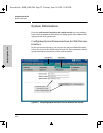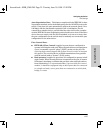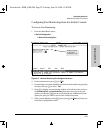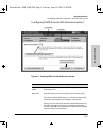
6-30
Configuring the Switch
Spanning Tree Protocol (STP)
Configuring the Switch
Spanning Tree Protocol (STP)
The switch uses the IEEE 802.1d Spanning Tree Protocol (STP), when enabled,
to ensure that only one path at a time is active between any two nodes on the
network. In networks where there is more than one physical path between
any two nodes, STP ensures a single active path between them by blocking all
redundant paths.
Enabling STP is necessary in such networks because having more than one
path between a pair of nodes causes loops in the network, which can result
in a switch detecting the same node on more than one port. This results in
duplication of messages, leading to a “broadcast storm” that can bring down
the network.
Enabling STP also allows you to intentionally create redundant links in your
network for critical communication paths. While allowing only one active path
through a network at any time, STP retains any redundant physical path to
serve as a backup (blocked) path in case the existing active path fails.
From the web browser interface you can activate the IEEE 802.1d Spanning
Tree Protocol (STP); from the switch console you can activate STP and adjust
spanning tree parameters. In the factory default configuration, STP is off. If
there are any redundant paths (loops) between nodes in your network, you
should set the Spanning Tree Enabled parameter to Yes.
Caution
Because the switch automatically gives faster links a higher priority, STP
selects the higher speed links as the active links unless there is an equipment
problem. Thus, the default STP parameter settings are usually adequate for
spanning tree operation. Because incorrect STP settings can adversely affect
network performance, you should avoid making changes without having a
strong understanding of how STP operates. For more on STP, read the IEEE
802.1d standard.
Sraswb.book : SIER_SW6.FM Page 30 Tuesday, June 30, 1998 12:20 PM


















